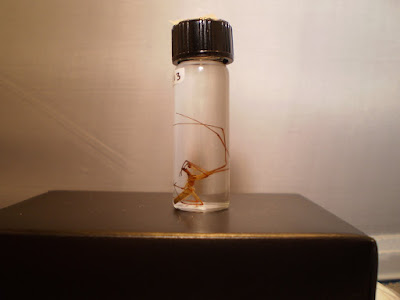
CC 036
Honorary Darwin Bill
Origin: Galapagos Islands
Unit: 500 New Sucres
Details: Extremely good quality
First off, I should be getting some new coin holders soon so I'll be able to get started on cataloging all of my coins. And second, today I am posting up that new piece in the coin collection that I was talking about last week. I'm sure you've been able to guess by now that today's bill is from none other than the Galapagos Islands. Now I'm sure that we are all aware that these islands are not their own country but rather a province of sorts. What I didn't realize was that they were part of Ecuador (I thought it was something like Peru, which is right below Ecuador).
So you may be wondering why there are bills specific to the Galapagos and why they don't use Ecuadorian money, which by the way Ecuador uses the monetary unit sucres. But you see, one company decided to print these special bills in order to commemorate the 200th birthday of Charles Darwin. There are a lot of commemorative coins and bills for certain people and events all over the world.
If you didn't know, the
Galapagos Islands are where the famed naturalist Charles Darwin spent a good deal of time studying the unique array of isolated animals eventually leading to his work on evolution and natural selection. So this bill, worth 500 new sucres (see what they did there?), was made last year to honor his legacy. The writing is all in Spanish, the official language of Ecuador and the Galapagos Islands, and features a single tortoise on the obverse with two tortoises, probably in some sort of mating ritual, on the reverse. Which of course are representations of probably the most well known species on the islands: the Galapagos Giant Tortoise (
Geochelone nigra). And the reverse also has a liking of Darwin himself.
Now you may be wondering if this money is usable, and the answer is that it depends. The company will present you with its exact worth (how much the bill is worth American and how much you payed for it) which is two dollars. But I've heard stories that some people will accept it down there as legal tender, but I'm not positive on that. But it makes an interesting exhibit nonetheless and represents one of the world's most breathtaking places. I definitely want to go there sometime in the future. Oh, and just for museum purposes the serial number is CD17536.
UPDATE: So I was just informed by my friend Kelsey, who has been to Ecuador, that Ecuador has actually been using the US dollar as it's official currency now. And while Americans hardly use the $1 Sacagawea coins, they are quite popular down there. The only official Ecuadorian money they seem to use are centavo coins now. But anyway I encourage anybody who reads any of my stuff and see any errors to please let me know, that way this site will be more informative and I'll learn something new as well.


















